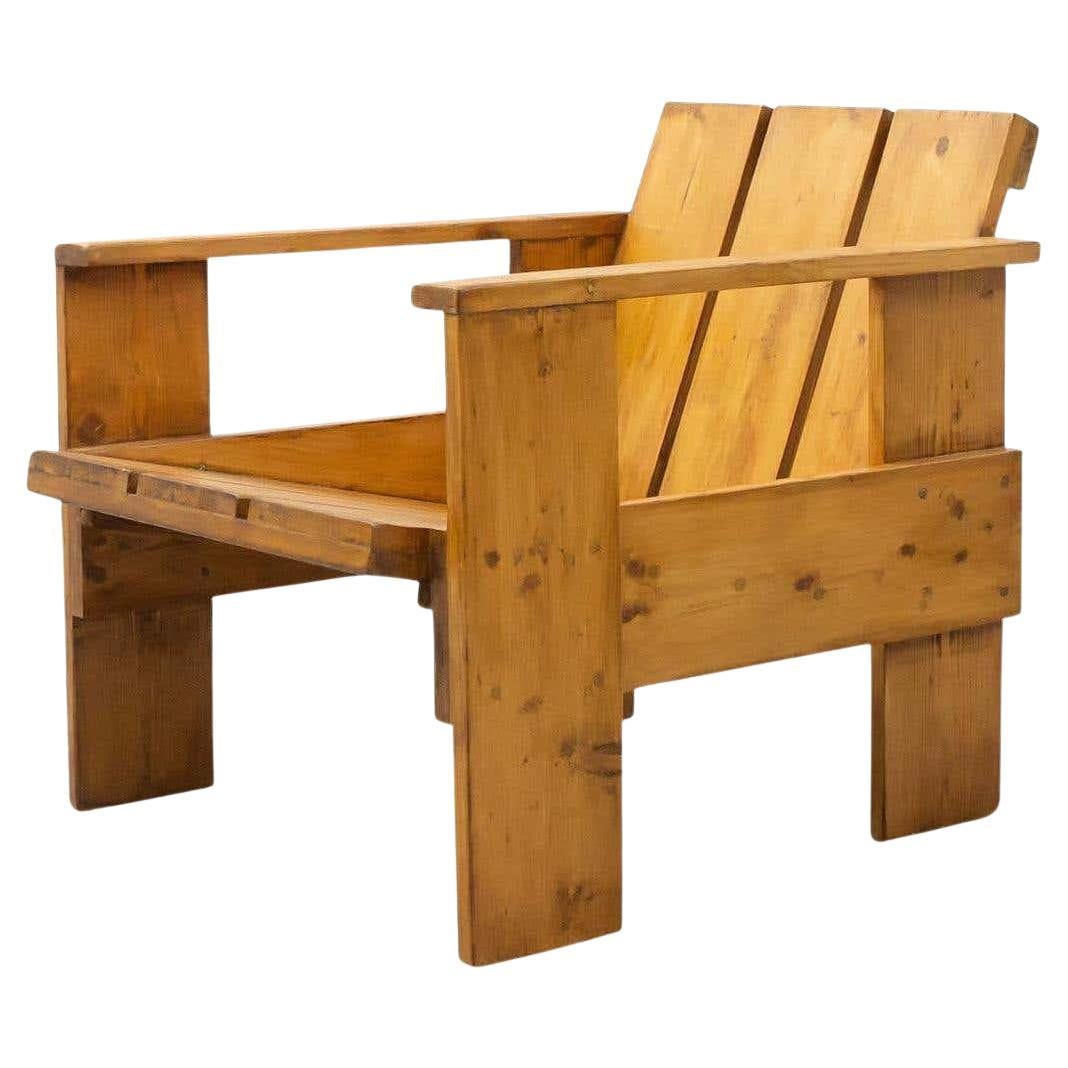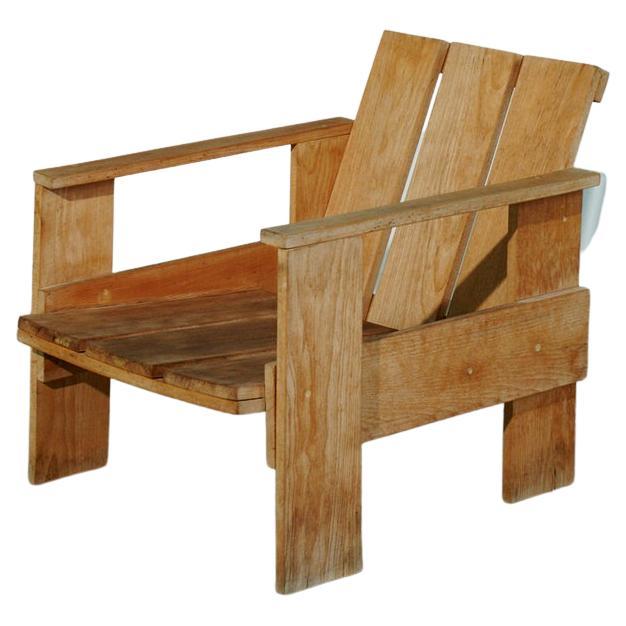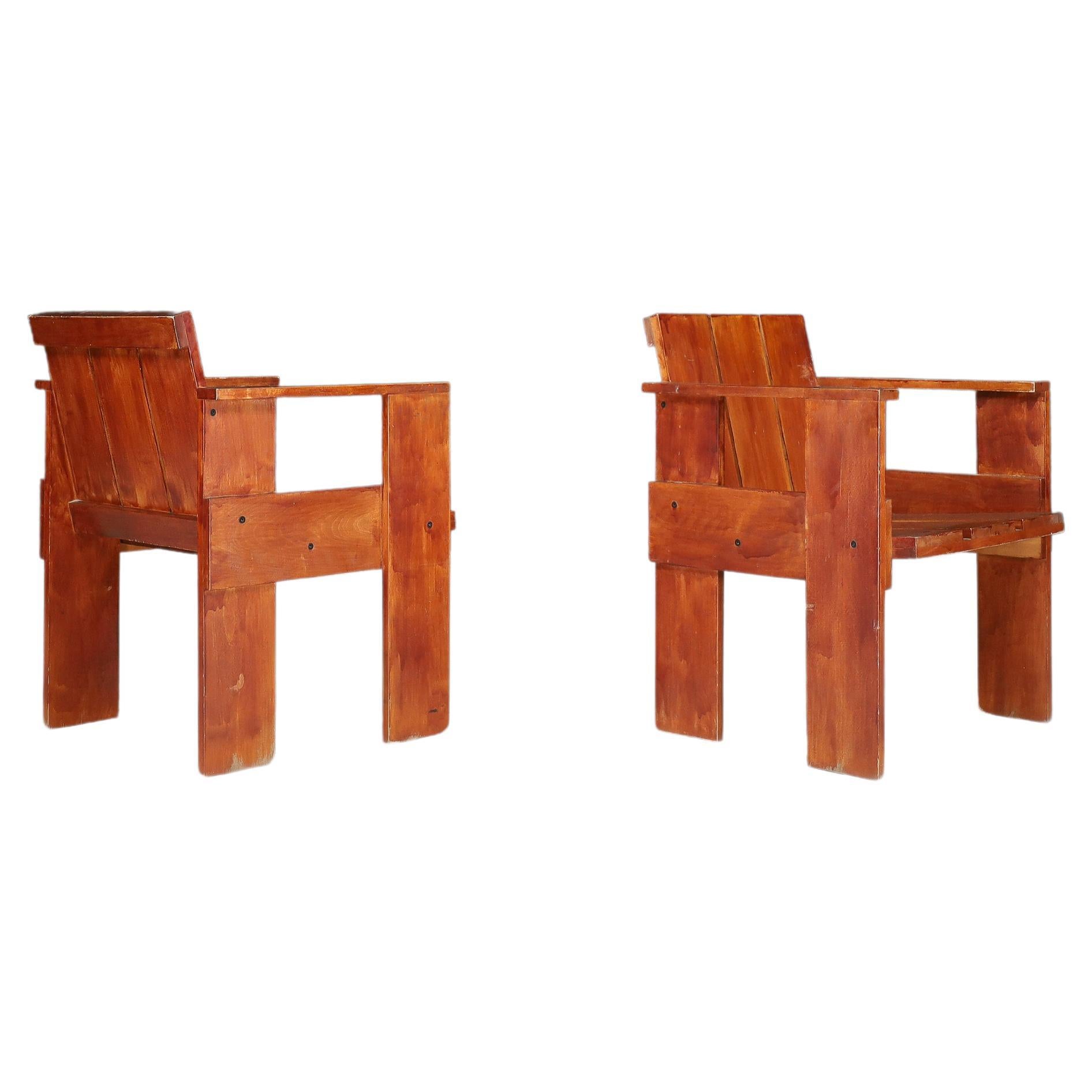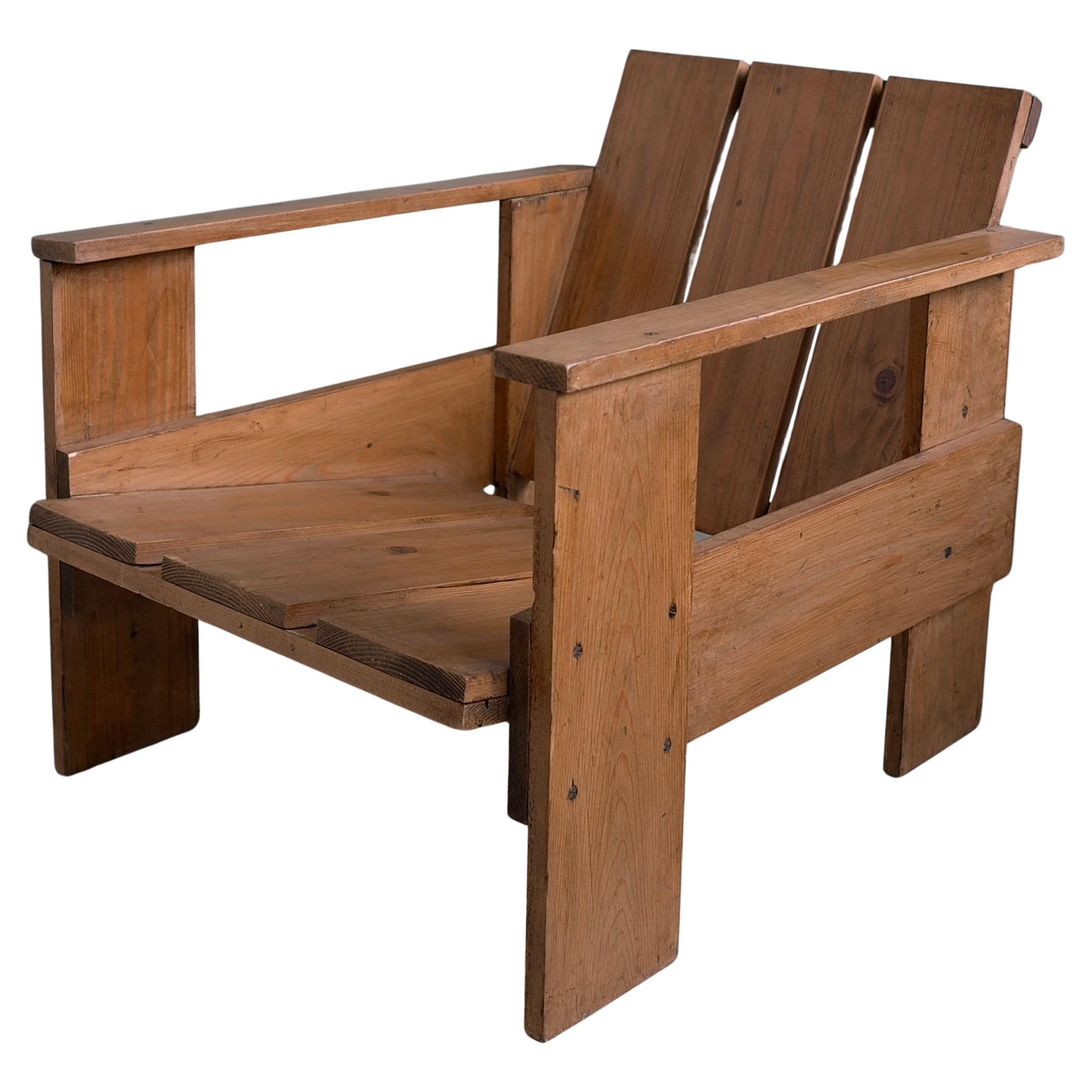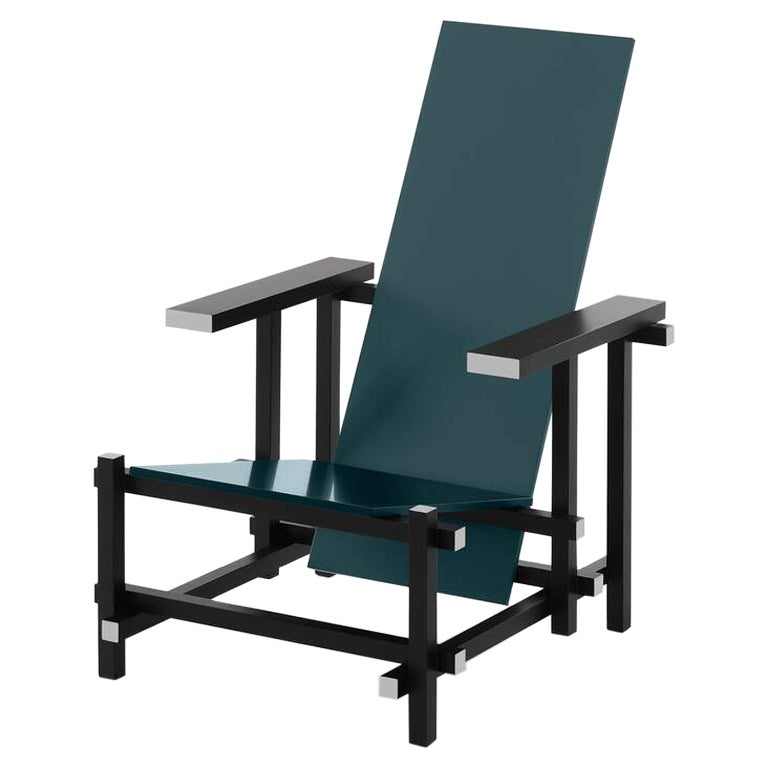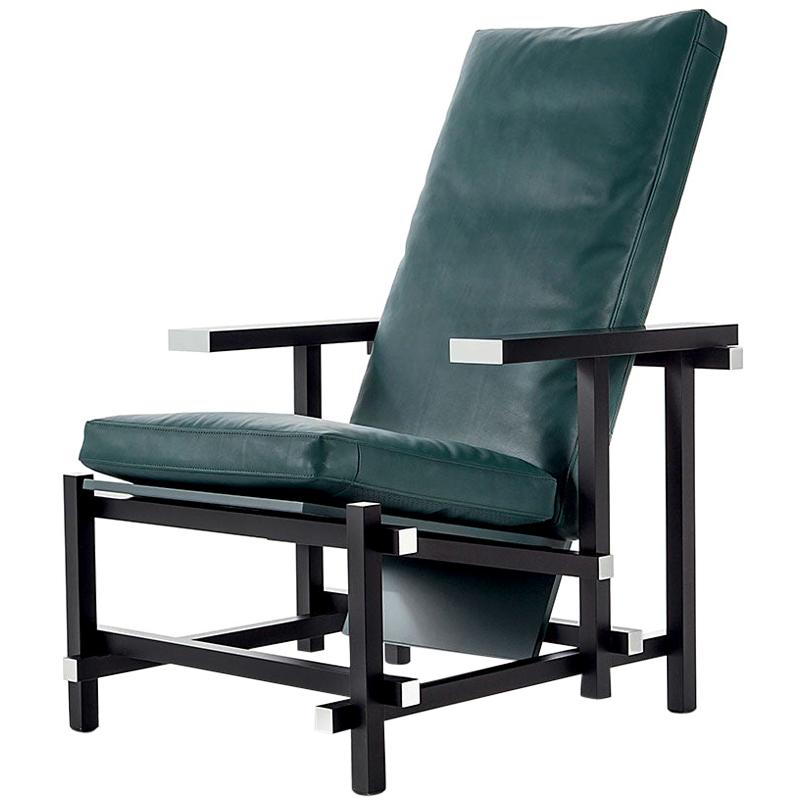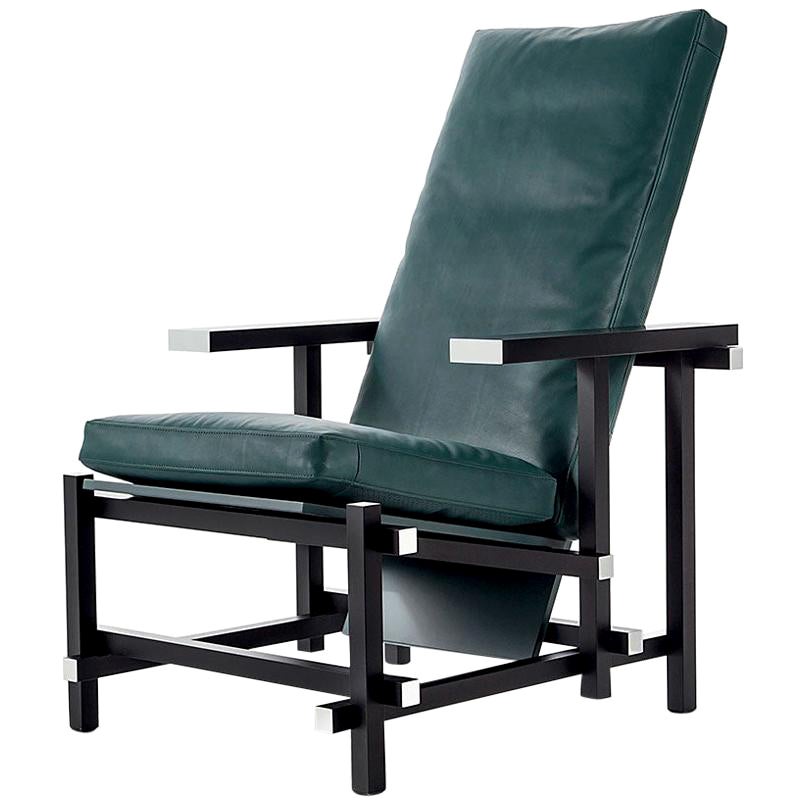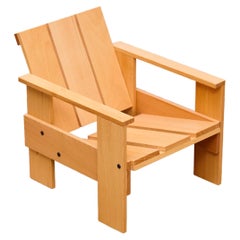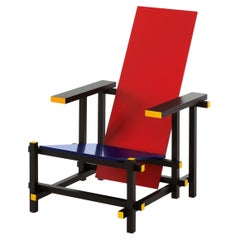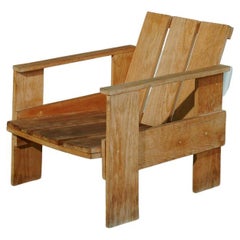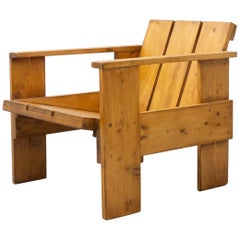
Gerrit Rietveld Mid-Century Modern Wood Crate Chair, circa 1950
View Similar Items
Want more images or videos?
Request additional images or videos from the seller
1 of 20
Gerrit Rietveld Mid-Century Modern Wood Crate Chair, circa 1950
About the Item
- Attributed to:Gerrit Rietveld (Designer)
- Dimensions:Height: 23.63 in (60 cm)Width: 22.84 in (58 cm)Depth: 28.55 in (72.5 cm)
- Style:Mid-Century Modern (In the Style Of)
- Materials and Techniques:
- Place of Origin:
- Period:
- Date of Manufacture:circa 1950
- Condition:Wear consistent with age and use.
- Seller Location:Barcelona, ES
- Reference Number:1stDibs: LU1427222670002
About the Seller
4.9
Platinum Seller
These expertly vetted sellers are 1stDibs' most experienced sellers and are rated highest by our customers.
Established in 2015
1stDibs seller since 2015
1,622 sales on 1stDibs
Typical response time: 6 hours
More From This SellerView All
- Gerrit Rietveld Mid-Century Modern Wood Crate Chair, circa 1950By Gerrit RietveldLocated in Barcelona, BarcelonaCrate chair designed by Gerrit Thomas Rietveld, executed circa 1950 by Metz and Co in Holland. In good original condition, preserving a beautiful patina...Category
Vintage 1950s Dutch Mid-Century Modern Chairs
MaterialsWood
$7,775 Sale Price25% Off - Gerrit Rietveld Wood Child Armchair 'Crate' by Rietveld by Rietveld, circa 2005By Gerrit RietveldLocated in Barcelona, BarcelonaLow drawer chair in natural wood with lacquer for Children by Gerrit Rietveld. Produced by Rietveld family including individual number and chip. Beautiful and fun design. This chair ...Category
Early 2000s Dutch Mid-Century Modern Armchairs
MaterialsWood
- Gerrit Rietveld Red and Blue Chair by CassinaBy Cassina, Gerrit RietveldLocated in Barcelona, BarcelonaChair designed by Gerrit Rietveld in 1918. Relaunched in 1973. Manufactured by Cassina in Italy. A sculptural seat with a pure and rationalist form, this chair became an authentic Manifesto for Neoplasticism, embraced by the Dutch De Stijl movement in 1917. An outlook shared by Piet Mondrian, whose objective was to seek out the essential nature of things, combined with the harmonious equivalence of colours, and the use of right-angle. Rietveld produced his first prototypes in 1918, expressing the philosophy of organising space using the same colours for similar components. He later applied this same approach to separate out constructional elements according to their function. Thus the base was black, and the seats coloured. As a consequence, the name of the piece changed, from Slat Chair to Red and Blue. Important information regarding images of products: Please note that some of the images show other colors and variations of the model, these images are only to present interior design proposals. The item that is selling is on the first image. Important information regarding color(s) of products: Actual colors may vary. This is due to the fact that every computer monitor, laptop, tablet and phone screen has a different capability to display colors and that everyone sees these colors differently. We try to edit our photos to show all of our products as life-like as possible, but please understand the actual color may vary slightly from your monitor About the designer: Gerrit Thomas Rietveld, born in Utrecht on 24 June 1888, seems possessed of two personalities, each so distinct that one might take his work to be that of more than one artist. The first personality is that seen in the craftsman cabinet-maker working in a primordial idiom, re-inventing chairs and other furniture as if no one had ever built them before him and following a structural code all of his own; the second is that of the architect working with elegant formulas, determined to drive home the rationalist and neoplastic message in the context of European architecture. The two activities alternate, overlap, and fuse in a perfect osmosis unfolding then into a logical sequence. In 1918 Rietveld joined the “De Stijl” movement which had sprung up around the review of that name founded the year before by Theo van Doesburg. The group assimilated and translated into ideology certain laws on the dynamic breakdown of compositions (carrying them to an extreme) that had already been expressed in painting by the cubists: the “De Stijl” artists also carefully studied the architectonic lesson taught by the great Frank Lloyd Wright, whose influence was widely felt in Europe at that time. Collaborating first with Robert van’t Hoff and Vilmos Huszar...Category
2010s Italian Mid-Century Modern Armchairs
MaterialsWood
$5,350 / item - Gerrit Rietveld Zeilmaker Version of Black Red and Blue Chair by CassinaBy Cassina, Gerrit RietveldLocated in Barcelona, BarcelonaChair designed by Gerrit Rietveld in 1920. Relaunched in 2015. Manufactured by Cassina in Italy. One of the versions of the iconic model dated 1918. The structure is in black-stained beechwood with white contrasting parts. Seat and back in green lacquered multiplywood. The black red and blue (Zeilmaker version) born from Rietveld’s chromatic experimentation While researching the origins of the red and blue model in collaboration with the Rietveld heirs, it emerged that the key idea of the first prototypes was based on the concept of spatial organization expressed through the monochrome tones of its elements. The first version was in fact produced in 1918 in completely unpainted wood. In the following years Rietveld proposed various examples, either monochrome or painted in different colors, depending on the requirements of his customers and the interiors for which the chairs were intended. As such, it comes as no surprise to find this 1920s version, presented as part of Cassina’s MutAzioni selection, created for the school teacher Wicher Zeilmaker with a black frame with white ends and a dark green painted seat and backrest. It was Rietveld’s ever-increasing involvement in the De Stijl movement that led him to also use primary colors on this model in 1923, and as such the chair became a veritable manifesto for the emerging neoplastic movement. Initially dubbed slat chair, Rietveld only gave it the name red and blue in the 1950s following its chromatic evolution. The various owners of the different examples used the chair as an abstract-realist sculpture in their interiors and, in some cases, as a simple tool for sitting on, adding cushions to make it more comfortable, just like Cassina offers for the black red and blue today. Important information regarding images of products: Please note that some of the images show other colors and variations of the model, these images are only to present interior design proposals. The item that is selling is on the first image. Important information regarding color(s) of products: Actual colors may vary. This is due to the fact that every computer monitor, laptop, tablet and phone screen has a different capability to display colors and that everyone sees these colors differently. We try to edit our photos to show all of our products as life-like as possible, but please understand the actual color may vary slightly from your monitor About the designer: Gerrit Thomas Rietveld, born in Utrecht on 24 June 1888, seems possessed of two personalities, each so distinct that one might take his work to be that of more than one artist. The first personality is that seen in the craftsman cabinet-maker working in a primordial idiom, re-inventing chairs and other furniture as if no one had ever built them before him and following a structural code all of his own; the second is that of the architect working with elegant formulas, determined to drive home the rationalist and neoplastic message in the context of European architecture. The two activities alternate, overlap, and fuse in a perfect osmosis unfolding then into a logical sequence. In 1918 Rietveld joined the “De Stijl” movement which had sprung up around the review of that name founded the year before by Theo van Doesburg. The group assimilated and translated into ideology certain laws on the dynamic breakdown of compositions (carrying them to an extreme) that had already been expressed in painting by the cubists: the “De Stijl” artists also carefully studied the architectonic lesson taught by the great Frank Lloyd Wright, whose influence was widely felt in Europe at that time. Collaborating first with Robert van’t Hoff and Vilmos Huszar, then with Theo van Doesburg and Cornelius van Eesteren, Rietveld soon became one of the most distinguished interpreters of the neoplastic message. Among his most important works are: the Schröder house at Utrecht (1924); the “Row Houses” at Utrecht (1931-1934); the Dutch pavilion at the Venice Biennial (1954); the sculpture pavilion in the Rijksmuseum Kröller-Müller at Otterloo and the Van Gogh Museum in Amsterdam (1955). Out of his equally important furniture, Cassina has chosen for its own production: the “Red and Blue” (1918), the “Zig-Zag” (1934), the “Schröder 1...Category
2010s Italian Mid-Century Modern Armchairs
MaterialsLeather, Wood
- Gerrit Rietveld Zeilmaker Version of Black Red and Blue Chair by CassinaBy Cassina, Gerrit RietveldLocated in Barcelona, BarcelonaChair designed by Gerrit Rietveld in 1920. Relaunched in 2015. Manufactured by Cassina in Italy. One of the versions of the iconic model dated 1918. The structure is in black-stained beechwood with white contrasting parts. Seat and back in green lacquered multiplywood. The armchair can have a single seat and backrest cushion in fabric or leather. The black red and blue (Zeilmaker version) born from Rietveld’s chromatic experimentation While researching the origins of the red and blue model in collaboration with the Rietveld heirs, it emerged that the key idea of the first prototypes was based on the concept of spatial organization expressed through the monochrome tones of its elements. The first version was in fact produced in 1918 in completely unpainted wood. In the following years Rietveld proposed various examples, either monochrome or painted in different colors, depending on the requirements of his customers and the interiors for which the chairs were intended. As such, it comes as no surprise to find this 1920s version, presented as part of Cassina’s MutAzioni selection, created for the school teacher Wicher Zeilmaker with a black frame with white ends and a dark green painted seat and backrest. It was Rietveld’s ever-increasing involvement in the De Stijl movement that led him to also use primary colors on this model in 1923, and as such the chair became a veritable manifesto for the emerging neoplastic movement. Initially dubbed slat chair, Rietveld only gave it the name red and blue in the 1950s following its chromatic evolution. The various owners of the different examples used the chair as an abstract-realist sculpture in their interiors and, in some cases, as a simple tool for sitting on, adding cushions to make it more comfortable, just like Cassina offers for the black red and blue today. Production delay: 8-9 weeks Important information regarding images of products: Please note that some of the images show other colors and variations of the model, these images are only to present interior design proposals. The item that is selling is on the first image. Important information regarding color(s) of products: Actual colors may vary. This is due to the fact that every computer monitor, laptop, tablet and phone screen has a different capability to display colors and that everyone sees these colors differently. We try to edit our photos to show all of our products as life-like as possible, but please understand the actual color may vary slightly from your monitor About the designer: Gerrit Thomas Rietveld, born in Utrecht on 24 June 1888, seems possessed of two personalities, each so distinct that one might take his work to be that of more than one artist. The first personality is that seen in the craftsman cabinet-maker working in a primordial idiom, re-inventing chairs and other furniture as if no one had ever built them before him and following a structural code all of his own; the second is that of the architect working with elegant formulas, determined to drive home the rationalist and neoplastic message in the context of European architecture. The two activities alternate, overlap, and fuse in a perfect osmosis unfolding then into a logical sequence. In 1918 Rietveld joined the “De Stijl” movement which had sprung up around the review of that name founded the year before by Theo van Doesburg. The group assimilated and translated into ideology certain laws on the dynamic breakdown of compositions (carrying them to an extreme) that had already been expressed in painting by the cubists: the “De Stijl” artists also carefully studied the architectonic lesson taught by the great Frank Lloyd Wright, whose influence was widely felt in Europe at that time. Collaborating first with Robert van’t Hoff and Vilmos Huszar, then with Theo van Doesburg and Cornelius van Eesteren, Rietveld soon became one of the most distinguished interpreters of the neoplastic message. Among his most important works are: the Schröder house at Utrecht (1924); the “Row Houses” at Utrecht (1931-1934); the Dutch pavilion at the Venice Biennial (1954); the sculpture pavilion in the Rijksmuseum Kröller-Müller at Otterloo and the Van Gogh Museum in Amsterdam (1955). Out of his equally important furniture, Cassina has chosen for its own production: the “Red and Blue” (1918), the “Zig-Zag” (1934), the “Schröder 1...Category
2010s Italian Mid-Century Modern Armchairs
MaterialsWood, Leather
- Gerrit Rietveld Zeilmaker Version of Black Red and Blue Chair by CassinaBy Cassina, Gerrit RietveldLocated in Barcelona, BarcelonaChair designed by Gerrit Rietveld in 1920. Relaunched in 2015. Manufactured by Cassina in Italy. One of the versions of the iconic model dated 1918. The structure is in black-stained beechwood with white contrasting parts. Seat and back in green lacquered multiplywood. The armchair can have a single seat and backrest cushion in fabric or leather. The black red and blue (Zeilmaker version) born from Rietveld’s chromatic experimentation While researching the origins of the red and blue model in collaboration with the Rietveld heirs, it emerged that the key IDEA of the first prototypes was based on the concept of spatial organization expressed through the monochrome tones of its elements. The first version was in fact produced in 1918 in completely unpainted wood. In the following years Rietveld proposed various examples, either monochrome or painted in different colors, depending on the requirements of his customers and the interiors for which the chairs were intended. As such, it comes as no surprise to find this 1920s version, presented as part of Cassina’s MutAzioni selection, created for the school teacher Wicher Zeilmaker with a black frame with white ends and a dark green painted seat and backrest. It was Rietveld’s ever-increasing involvement in the De Stijl movement that led him to also use primary colors on this model in 1923, and as such the chair became a veritable manifesto for the emerging neoplastic movement. Initially dubbed slat chair, Rietveld only gave it the name red and blue in the 1950s following its chromatic evolution. The various owners of the different examples used the chair as an abstract-realist sculpture in their interiors and, in some cases, as a simple tool for sitting on, adding cushions to make it more comfortable, just like Cassina offers for the black red and blue today. Important information regarding images of products: Please note that some of the images show other colors and variations of the model, these images are only to present interior design proposals. The item that is selling is on the first image. Important information regarding color(s) of products: Actual colors may vary. This is due to the fact that every computer monitor, laptop, tablet and phone screen has a different capability to display colors and that everyone sees these colors differently. We try to edit our photos to show all of our products as life-like as possible, but please understand the actual color may vary slightly from your monitor About the designer: Gerrit Thomas Rietveld, born in Utrecht on 24 June 1888, seems possessed of two personalities, each so distinct that one might take his work to be that of more than one artist. The first personality is that seen in the craftsman cabinet-maker working in a primordial idiom, re-inventing chairs and other furniture as if no one had ever built them before him and following a structural code all of his own; the second is that of the architect working with elegant formulas, determined to drive home the rationalist and neoplastic message in the context of European architecture. The two activities alternate, overlap, and fuse in a perfect osmosis unfolding then into a logical sequence. In 1918 Rietveld joined the “De Stijl” movement which had sprung up around the review of that name founded the year before by Theo van Doesburg. The group assimilated and translated into ideology certain laws on the dynamic breakdown of compositions (carrying them to an extreme) that had already been expressed in painting by the cubists: the “De Stijl” artists also carefully studied the architectonic lesson taught by the great Frank Lloyd Wright, whose influence was widely felt in Europe at that time. Collaborating first with Robert van’t Hoff and Vilmos Huszar, then with Theo van Doesburg and Cornelius van Eesteren, Rietveld soon became one of the most distinguished interpreters of the neoplastic message. Among his most important works are: the Schröder house at Utrecht (1924); the “Row Houses” at Utrecht (1931-1934); the Dutch pavilion at the Venice Biennial (1954); the sculpture pavilion in the Rijksmuseum Kröller-Müller at Otterloo and the Van Gogh Museum in Amsterdam (1955). Out of his equally important furniture, Cassina has chosen for its own production: the “Red and Blue” (1918), the “Zig-Zag” (1934), the “Schröder 1...Category
2010s Italian Mid-Century Modern Armchairs
MaterialsLeather, Wood
You May Also Like
- Crate Chair by Gerrit Rietveld, Designed in 1930s The NetherlandsBy Cassina, Gerrit RietveldLocated in Hellouw, NLNice Gerrit Rietveld 'Crate' chair. This chair is designed in 1934, however, we think this is a Cassina edition from the 1970s. This chair is made out of ash wood and has a colorless lacquer. 'Gerrit Rietveld designed the 'crate' series of furniture built from standardized pine boards – cheap material for packing crates – which were soon well-known as ‘crate furniture’. 'From 1935 on the progressive designs appeared at Metz & Co, where furniture by Rietveld had already been sold since 1930. The crate desk...Category
Vintage 1930s Dutch Mid-Century Modern Armchairs
MaterialsPine
- ‘Crate’ Chair in Wood, Attributed to Gerrit RietveldBy Gerrit RietveldLocated in Berlin, BE‘Crate’ chair in wood, Attributed to Gerrit Rietveld Additional information: Material: Wood Designer: Gerrit Rietveld Size: 61 W x 54 D x 70 H cm.Category
Vintage 1980s Chairs
MaterialsWood
- Gerrit Rietveld for Cassina Crate Chairs, Italy, 1970sBy Cassina, Gerrit RietveldLocated in Almelo, NLGerrit Rietveld for Cassina crate chairs, Italy 1970s. Pair of two Gerrit Rietveld' Crate' chairs. These chairs were designed in 1934 and produced by...Category
Vintage 1970s Italian Modern Armchairs
MaterialsAsh
- Crate Chair in style of Gerrit Rietveld, The Netherlands 1960'sBy Gerrit RietveldLocated in Den Haag, NLCrate Chair in style of Gerrit Rietveld, The Netherlands 1960's. In solid Pinewood with lovely patina and wear.Category
Vintage 1960s Dutch Mid-Century Modern Armchairs
MaterialsPine
- Gerrit Rietveld Red and Blue Chair for Cassina, Italy, newBy Cassina, Gerrit RietveldLocated in Berlin, DEChair designed by Gerrit Rietveld in 1918. Relaunched in 1973. Manufactured by Cassina in Italy.Category
21st Century and Contemporary Italian Chairs
MaterialsWood
- Gerrit Rietveld Mondial ChairBy Gerrit RietveldLocated in Dronten, NL‘Mondial’ chair designed by Gerrit Rietveld for the 1958 World Exhibition in Brussels. This chair is a later reissue by ‘Rietveld Originals’ and manufactured by Gispen. The Mondial...Category
21st Century and Contemporary Dutch Mid-Century Modern Chairs
MaterialsAluminum, Steel
$750 / item
Recently Viewed
View AllMore Ways To Browse
Retro French Style Chairs
White Lacquered Chairs
Circa 1900 Chair
White Lacquer Chair
Italian Animal Skin Chairs
Modern Faux Leather Chairs
Two Seat Curved
2020 Chair
Director Chair
Round Seating
Old Wood Chair
In The Style Of Ponti
Modern Wood Leather Black Chair
Gray Metal Chairs
High End Leather
Italian Chair 19th
Curved Two Seater
Italian Chairs 19th Century Chairs

